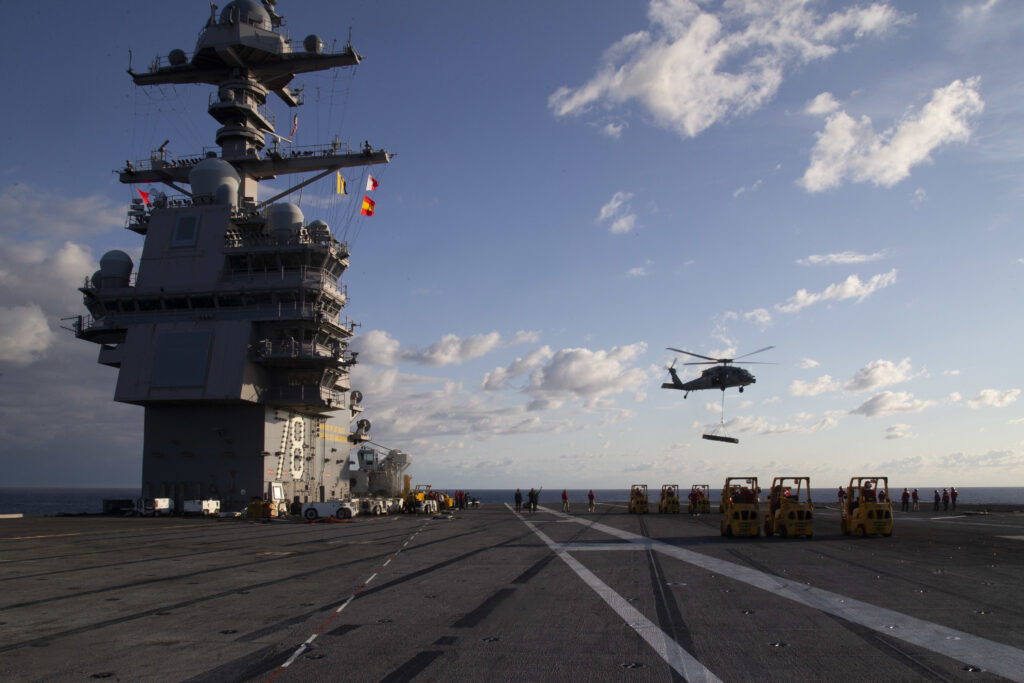Gerald R. Ford to Deploy at Last, With Slightly Reduced Air Wing

ARLINGTON, Va. — The lead ship U.S. Navy’s newest class of nuclear-powered aircraft carrier, USS Gerald Ford (CVN 78), will depart Norfolk, Virginia, next week on its first major deployment. The carrier is scheduled to deploy next year in support of regional combatant commanders.
The Ford is making what the Navy calls a “service-retained” deployment, meaning it is operating by the authority of the chief of naval operations under command and control of the U.S. 2nd Fleet, rather than under the command and control control of a regional combatant commander under the Global Force Management Concept.
Vice Adm. Daniel Dwyer, commander of the U.S. 2nd Fleet, said Carrier Strike Group 12 (CSG 12), of which the Ford is a part, will range throughout the Atlantic Ocean operating with navies of allied and partner nations.
Dwyer, speaking to reporters Sept. 26, said the deployment would provide the Ford CSG commander “a chance to test the carrier’s air operability prior to embarking on its first Global Force Management deployment next year. This historic service-retained deployment is an opportunity for the U.S. Navy to come together with other members of the NATO Alliance to exercise and train together within the Atlantic and its littorals while testing out advanced technologies on the first new class of U.S. aircraft carrier in more than 40 years.”
CSG-12 and Destroyer Squadron Two staffs will be embarked in the Ford, as will Carrier Air Wing Eight. Deploying with the group will be Ticonderoga-class guided-missile cruiser USS Normandy (CG 60); the Arleigh Burke-class guided-missile destroyers USS Ramage (DDG 61), USS McFaul (DDG 74), and USS Thomas Hudner (DDG 116); the Legend-class national security cutter USCGC Hamilton (WMSL 753); the Henry J. Kaiser-class fleet replenishment oiler USNS Joshua Humphpries (T-AO 188), and the Lewis and Clark-class dry cargo and ammunition ship USNS Robert E. Peary (T-AKE 5).
Units from eight allied and partner nations that will operate with the CSG and include ships from Canada, Denmark, Finland, France, Germany, The Netherlands, Spain and Sweden. The CSG includes 17 ships and one submarine.
While deployed, the Ford CSG will conduct group steaming, air-defense exercises, maritime domain awareness, long-range maritime strike, distributed maritime operations, antisubmarine warfare exercises and naval integration, Dwyer said.
“Innovation and interoperability are the key focal points of this deployment,” Dwyer said. “And we will work together with allies and partner nations to strengthen our collective defense of the Atlantic by maturing our integration for future maritime operations.”
All eight squadrons of Carrier Air Wing Eight will be onboard for the deployment but some will not be at full strength in terms of numbers of aircraft.
“It won’t be the full complement, but it will be nearly the entire air wing,” Dwyer said. “And that is not because of any lack of capacity aboard Ford, but only where the air wing is in the Global Force Management process. We’re still sizing the numbers, but it will be a fairly full air wing, but not the complete air wing.”
New Technology
The Ford, commissioned in 2017, is deploying with 43 new technologies, including the Electro-Magnetic Aircraft Launch System, and the Advanced Arresting Gear.
The Ford’s commanding officer, Capt. Paul Lanzilotta, said in a Sept. 29 interview that all systems have been tested and are ready to go, and some will go through further operational testing.
Lanzilotta, a native on Long Island, New York, is an E-2 Hawkeye naval flight officer. He said the Ford has “incredible network connectivity.”
Several Ford crew members were made available for interviews on Sept. 29 pierside in Norfolk.
Chief Machinist’s Mate (select) Kera Archambeault, who accrued two previous deployments on the Nimitz-class aircraft carrier USS Carl Vinson (CVN 70), said the Ford has better amenities for the crew, “like all spaces having better air conditioning, the food is really good, the gallies are really open to bring everyone together.”
“We’re very by the book here,” said Boatswain’s Mate Second Class Patrick Schlosser, for whom this will be his first deployment, asked about the ease of maintenance on a new ship. “There are a lot of new systems — this is the biggest, the baddest, the newest ship in the fleet — there are a lot of learning curves that we have to get across. We are able to conduct and do what we need to do regularly with a relative amount of ease and we’re pretty efficient at it. … This crew is ready for anything that comes at us. Everybody would overcome any obstacle that they deal with as far as maintenance goes and any equipment that we deal with.”